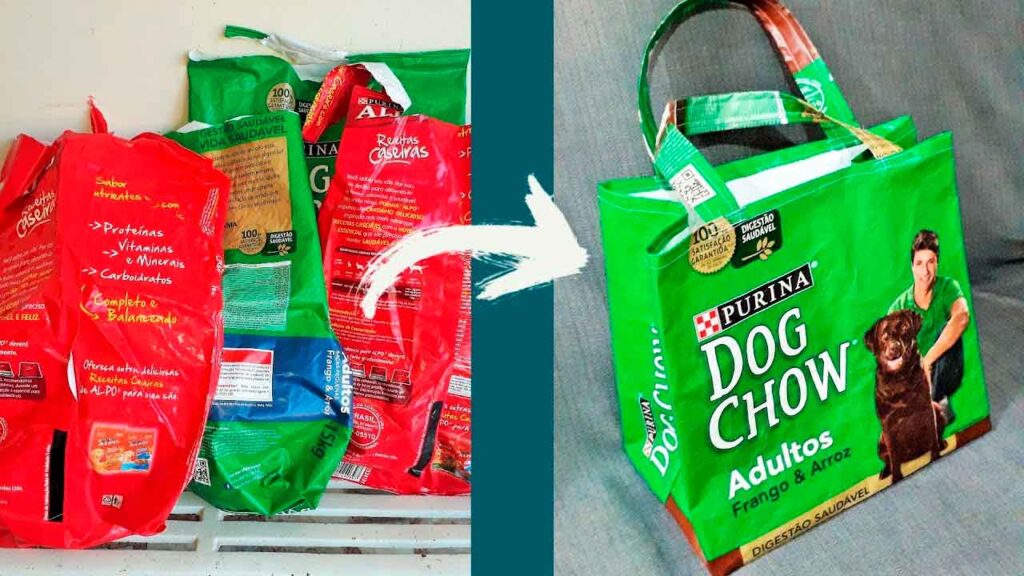Anúncios
The eco-friendly bag trend is gaining momentum, fueled by growing awareness of the importance of recycling and sustainability. Instead of buying new bags, why not create your own eco-friendly bag from recyclable materials that you already have around your home? This guide details the process of making a bag by reusing everyday packaging and turning it into unique and stylish accessories.

Packaging Selection and Preparation
To start making your eco-friendly bag, you need to select the right packaging. Any sturdy packaging can be used, such as long-life packaging, grated cheese, coffee powder, or even pet food. The more well-known the brand of the packaging, the more your bag will gain a Pop Art touch, transforming a simple accessory into a bold and expressive fashion piece.
The first step is to thoroughly clean the packaging using soap and water. This cleaning is essential to ensure that there are no residues that could compromise the durability of the bag. After cleaning, let the packaging dry completely. Then, cut the packaging so that they are symmetrical in size, preparing them for sewing.
Materials Needed for Making
In addition to the packaging, you will need some basic materials to make the eco-friendly bag:
- Sewing machine (and the skills to use it)
- 14 identically sized packaging faces
- Scissors
- Velcro tapes
These materials are easy to find and often already available at home, making the project accessible and affordable. A sewing machine is essential to ensure the bag is sturdy, especially since recycled packaging can be more difficult to sew than conventional fabrics.
Starting Sewing
Once the bags are clean and ready, the next step is to start sewing. Sewing should be done in pairs, joining two bags at a time to form the sides of the bag. It is important to test different types of thread for each type of bag, making sure that the bag will not tear easily during sewing.
Once you have paired the bags, join two of them together to create one side of the bag. The bottom of the bag will be smaller than a pair of bags, so you will need to measure the exact size and fold the bag to ensure it is stronger. This step is crucial because the bottom of the bag needs to support the weight of the items you are carrying.
Ecological Bag Assembly
With the sides and bottom ready, it’s time to assemble the eco-friendly bag. Each side is made from a pair of packaging materials, which must be sewn together at the bottom. Assembling the bag requires patience and precision to ensure that all the parts are aligned and sewn securely.
An important detail is the possibility of using closed packaging to make the bag even more resistant. However, if you choose this method, make sure that the packaging is completely clean inside to avoid any unwanted odors or residue.
Closing and Finalization
Once the bag is assembled, the next step is to close all the sides, leaving only the opening of the bag unsewn. To give it a finishing touch, it is recommended to fold the sides inwards, which can be done using different techniques, such as using an iron, your hands or a ruler, depending on the packaging material.
To close your eco-friendly bag, add a piece of Velcro near the opening of the bag. Fold the top of the bag over and place another piece of Velcro on the inside of the lid, creating a secure and practical closure. Velcro is a great choice because it is easy to use and offers durability.
Enjoying Your Eco-Friendly Bag
Now that your bag is ready, you can wear it with pride, knowing that you’ve contributed to recycling and sustainability. In addition to being a fashionable piece, your eco-friendly bag is an expression of your creativity and environmental awareness. Every time you go out with it, you’ll be promoting the importance of recycling and inspiring others to do the same.
Making eco-friendly bags from recycled packaging is a practical way to reduce waste and create unique accessories. This process transforms items that would otherwise be discarded into something useful and stylish, reinforcing the idea that fashion and sustainability can go hand in hand. By reusing packaging, you not only help reduce your environmental impact, but you also add a touch of originality to your personal style.
Eco-friendly bags made from recycled materials are a great alternative to conventional bags, which are often mass-produced and contribute to the accumulation of waste on the planet. By choosing to create your own bag, you are taking a conscious approach to the environment, while also creating a unique piece that reflects your personality and commitment to sustainability.
Environmental Impact and Sustainable Fashion
The use of eco-friendly bags made from recycled materials is a practice that is increasingly gaining ground in sustainable fashion. The fashion industry is one of the biggest polluters in the world, and initiatives such as making eco-friendly bags from packaging help to mitigate this impact. By reusing materials that would otherwise be discarded, you are contributing to the reduction of waste and promoting a more sustainable and ethical approach to fashion.
Sustainable fashion is not just about following trends, but about making conscious choices that reflect a concern for the environment and future generations. Creating your own eco-friendly bags is a way to actively participate in this change, demonstrating that it is possible to be fashionable without sacrificing sustainability.
An eco-friendly bag made from recycled packaging is much more than just an accessory; it’s a symbol of creativity, sustainability, and environmental responsibility. By following the steps in this guide, you’ll not only create a unique and stylish bag, but you’ll also be part of a larger movement toward a more sustainable world. Every eco-friendly bag you create is a step toward a future where fashion and environmental awareness go hand in hand.
Learn how to make other arts by recycling, Click here.
Check out interesting facts about recycling clicking here.



